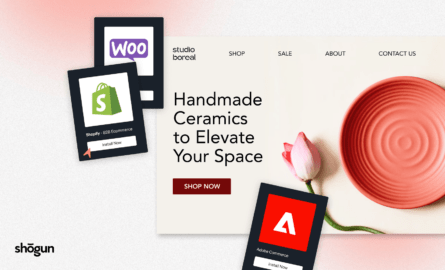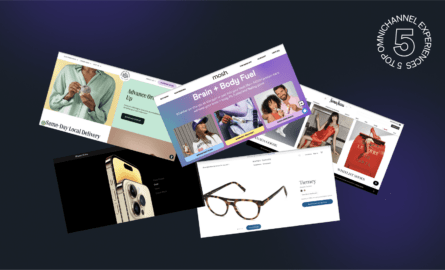You Need to Adapt Your Ecommerce Brand in This Time of Disruption

While consumers had to shop online last year, they don’t this year—meaning, you need a good reason for them to stay online and buy from your store. Bricklin Dwyer, Chief Economist at Mastercard, shared that—of the $900 billion in extra digital spending from the pandemic—between 20-30% is expected to continue over the next few years. This explosive growth is good for your store, but comes with a challenge: competition.
Your brand needs to maintain a competitive edge as things continue to morph and change, so we talked with experts across ecommerce to see what you might expect amid the return to in-person retail, what trends are likely to stick, and recommendations for how you can adapt.
How ecommerce continues to evolve
From SMS marketing to headless commerce, the experts we spoke with told us just how they saw things change during 2020 and early 2021.
There’s a new bar for customer service
Since the start of COVID, businesses have seen support requests go up by 20%. And according to Chris Lavoie, senior technology partner manager at Gorgias, “Many brands were ill-prepared for this influx in support inquiries, leaving customers unsatisfied.”
Since unsatisfied customers have a 58% chance of not shopping with a given business anymore, brands needed to strengthen their customer service options online. As Lavoie said, “We witnessed huge adoption in support technology like Gorgias [an integrated help desk for ecommerce], which, importantly, is built to scale.” He said that throughout the pandemicbrands looked at more ways to be available to help on all channels, including social media rather than just the standard email or chat.
Going forward, he says companies will continue amping up their support across channels, even with a return to in-person retail:

SMS marketing became even more popular
Evan Romano, a technical partner manager at Postscript, an SMS marketing company focused on helping Shopify business owners says his team saw an uptick in companies using SMS. “The chances of us talking to brands who don’t have an SMS program is getting lower and lower.”
According to Zipwhip, 70% of businesses now use texting to reach customers—up 3% from pre-pandemic. Of that 3% increase, 34% began using SMS marketing as a direct result of COVID. As things start to open, Romano said that brands are using customer data like a person’s geographical location vs. in-person retail presence to target certain phones with relevant deals.

Evan’s advice for brands moving forward? Show personality and talk like you’re talking to another person with SMS. Aim to make your short messages relatable rather than simply using discount blasts all the time.
Potential shoppers opened emails more
According to Omnisend, the year-over-year open rate for emails grew by over 30% in 2020. This number is expected to remain high in 2021 and beyond. One reason for the higher open rates might be thatbusinesses sent emails less often.
However, there are reservations about relying on open rates as a signal going forward. When talking withVal Geisler, a speaker at our upcoming Xperience Commerce and the customer evangelist at Klaviyo, she warned that while email open rates will still be viewable on Andriod and Windows, iOS 15 will eliminate open rates which could see a reduction in useable data.
Even still, Val says:

By engaging further with your most engaged audience, you create brand evangelists for life.
Interest in headless commerce increased
Interest in headless commerce existed pre-pandemic; but more online shopping only accelerated the trend, according to Nicholas DeNitto, co-founder of Manufactur, a branding web design agency. This is because headless progressive web apps allow for unparalleled site speed and help brands achieve far greater customization than many of the out-of-the-box themes available on traditional ecommerce platforms.
Headless commerce refers to using a separate piece of technology to power your ecommerce site’s frontend vs. the technology you use for the backend.
On brand’s interest in more flexible frontends or presentation layers to pair with their existing backend setups, DeNitto confirmed, demand is up. Specifically, he said there had been increased attention since the beginning of 2021:
“As of the start of the year, [site] speed became an even more important factor in your SEO ranking, so that’s another factor that comes to mind [for ecommerce sites].”
DeNitto expects the trend toward headless to continue:

#cta-mini-fe#Wondering if a headless frontend is for you? See this tech in action.Request a demo
Competition continues as COVID subsides
Earlier this year, our original research at Shogun found that 51% of consumerssaid they shop more online now than pre-pandemic. Moreover, consumers spent nearly $900billion online in 2020—totalling about $1 online for every $5 spent. This shopping behavior is only expected to continue.
However, while online shopping is up, 37% of Americans still report they prefer shopping from big chain websites rather than direct-to-consumer websites, and 22% said that they don’t plan to keep most of their shopping experience online as COVID continues to subside.
This means that as COVID precautions lift, ecommerce brands face competition from both in-person retail and their online competitors. With much of the U.S. population now fully vaccinated, and restrictions all across the U.S. either ending soon or already lifted, if you haven’t found your competitive edge, you need to soon.
Jumpstarting your competitive edge
Here are a few ways to accelerate your store’s growth based on the trends our experts shared above:
See if headless commerce is right for you
Headless commerce will remain a high priority for brands using platforms like Shopify, BigCommerce, and others. A more flexible frontend helps you win customer attention (and conversions) quickly with a highly performant and eye-catching site. Unlike standard stores, headless PWAs load faster and are entirely within your control design wise, without speed tradeoffs.
According to David Schripsema, director of retail technology at Assemble:
“in all of the uncertainty of the past 16 months, one thing seems to be pretty clear for retailers: customers want experience with a brand.”
Headless commerce is able to provide this personal experience with a brand—with especially on-brand shopping or look and feel—where out-of-the-box websites can lack this ability.
Schripsema advises ecommerce CMOs: “When choosing where to spend this pent-up capital, experience will rank higher than ever on customers’ list of priorities.”
#cta-mini-fe#Want to personalize your ecommerce experience, too? Shogun Frontend can help.Book a demo
Keep up with customer service best practices
Smooth experiences are best for satisfied customers, and according to Lavoie, “By offering truly frictionless & exceptional shopping experiences, brands can absolutely retain customers even as they look to brick-and-mortar shopping.” He went on to say that brands that saw the pandemic as a chance to earn consumer trust would be one step ahead in terms of keeping them loyal in the post-COIVD world.
One step ahead or not, any brand working to build consumer relationships should be everywhere. Lavoie said, “Modern ecomm brands need to be connected to consumers with open lines of communication across all channels, especially social media.” And Zendesk agrees—they’ve found over 70% of customer support agents use more than one line of communication to solve customer issues.
Mine customer review data for re-marketing opportunities
Customer reviews often come with a plethora of back-end data that companies can use, including email, name, product purchased, age, gender, and interest level, depending on where someone left a review.
Lindsay Kolinsky, the partner marketing manager from Okendo,said that reviews and review data are valuable for personalized omnichannel marketing.

With more first-party data now than before the pandemic (thanks to an increase in review generation), Kolinsky says that this can help your direct-to-consumer store increase the chance of repeat and new sales.
Learn how to adapt to the changing state of ecommerce
The ever-evolving pandemic changed how people interacted with brands online and propelled ecommerce forward as in-person shopping closed. However, to take advantage of continued growth, ecommerce brands need to stay agile.
Going forward, brands will face more competition from all directions, making differentiation vital into 2022.
#cta-visual-fe#<cta-title>Build a PWA for your brand<cta-title>Shogun Frontend is the easiest way to launch a PWA for your store.Learn more
The Shogun Team
Shogun's team is full of whipsmart ecommerce experts, dedicated to making the process of building and customizing your Shopify store simpler, faster, and more intuitive.



